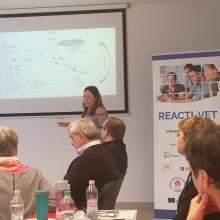Results

Based on the experiences of the pilots, the consortium developed a new, responsive methodology, which will enable leaders and teachers in vocational education to respond quickly, addressing skill gaps identified by the labour market, which itself is changing at a pace never experienced before.

In the 4th phase of the project upskilling courses for students were designed and delivered in Hungary and in Estonia.
Teams of VET teachers made contact with local companies and reached an agreement with one of them. As a next step, skill mismatches and training needs were identified in collaboration of the company representative and the teachers. The company assigned a project task to a team of students, in relation to the identified skill gaps, then a curriculum was designed for a short upskilling course for the students, providing them with the necessary knowledge and skills to successfully complete the project task.

The consortium partners of Reacti-VET project, led by the UK partner (CAPDM Ltd.), have reviewed the educational frameworks developed by the EU (such as EQF, e-Competence Framework, DigComp 2.1 and DigCompEdu, EQAVET and ECVET) and based on the analyses they have agreed that Reacti-VET teachers’ training program fits into the EQF and DigCompEdu frameworks.

The second intellectual outcome - O2 Upskilling Training for Teachers - is a multilingual 'Learning Management' and 'Learning Content Management System' platform for delivering the upskilling course for teachers. The English learning content has been translated into partner national languages and implemented along with additional course components - sets of competences, exercises, assignments, web 2.0 tools, etc. The platform supports social learning and collaboration, the customized graphical design and house styles and standard, user friendly navigation tools.

During the 1st phase of the project, the project partners were involved in 3 main activities. Initially the project website was created, with a public front end, and a back end only accessible for partners, used for collaborative document handling and online communication. The platform was presented to partners on the kick-off meeting. As a next step, a focused requirement analysis was performed in Italy, Estonia and Hungary.

 Multiplier event - Hungary -
Multiplier event - Hungary -









 Back to the top
Back to the top